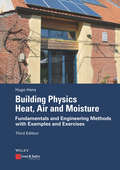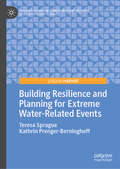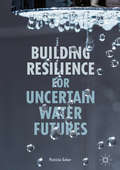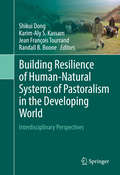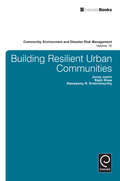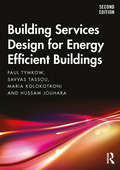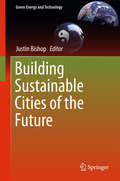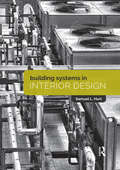- Table View
- List View
Building Physics - Heat, Air and Moisture: Fundamentals and Engineering Methods with Examples and Exercises
by Hugo S. HensBad experiences with construction quality, the energy crises of 1973 and 1979, complaints about "sick buildings", thermal, acoustical, visual and olfactory discomfort, the need for good air quality, the move towards more sustainability - all these have accelerated the development of a field that, for a long time, was hardly more than an academic exercise: building physics (in English speaking countries sometimes referred to as building science). The discipline embraces domains such as heat and mass transfer, building acoustics, lighting, indoor environmental quality and energy efficiency. In some countries, fire safety is also included. Through the application of physical knowledge and its combination with information coming from other disciplines, the field helps to understand the physical phenomena governing building parts, building envelope, whole buildings and built environment performance, although for the last the wording "urban physics" is used. Today, building physics has become a key player on the road to a performance based building design. The book deals with the description, analysis and modeling of heat, air and moisture transport in building assemblies and whole buildings with main emphasis on the building engineering applications, including examples. The physical transport processes determine the performance of the building envelope and may influence the serviceability of the structure and the whole building. Compared to the second edition, in this third edition the text has partially been revised and extended.
Building Physics - Heat, Air and Moisture: Fundamentals and Engineering Methods with Examples and Exercises
by Hugo S. HensBad experiences with construction quality, the energy crises of 1973 and 1979, complaints about "sick buildings", thermal, acoustical, visual and olfactory discomfort, the need for good air quality, the move towards more sustainability - all these have accelerated the development of a field that, for a long time, was hardly more than an academic exercise: building physics (in English speaking countries sometimes referred to as building science). The discipline embraces domains such as heat and mass transfer, building acoustics, lighting, indoor environmental quality and energy efficiency. In some countries, fire safety is also included. Through the application of physical knowledge and its combination with information coming from other disciplines, the field helps to understand the physical phenomena governing building parts, building envelope, whole buildings and built environment performance, although for the last the wording "urban physics" is used. Today, building physics has become a key player on the road to a performance based building design. The book deals with the description, analysis and modeling of heat, air and moisture transport in building assemblies and whole buildings with main emphasis on the building engineering applications, including examples. The physical transport processes determine the performance of the building envelope and may influence the serviceability of the structure and the whole building. Compared to the second edition, in this third edition the text has partially been revised and extended.
Building Physics - Heat, Air and Moisture: Fundamentals, Engineering Methods, Material Properties and Exercises
by Hugo S. HensBad experiences with construction quality, the energy crises of 1973 and 1979, complaints about "sick buildings", thermal, acoustical, visual and olfactory discomfort, the need for good air quality, the move towards energy efficiency, decarbonization and sustainability ? all these have accelerated the development of a discipline that, for a long time, was hardly more than an academic exercise: building physics. The discipline embraces domains such as heat and mass transfer, building acoustics, lighting, indoor environmental quality, energy efficiency, and, in some countries, fire safety. Through the application of physical knowledge and its combination with information coming from other disciplines, building physics helps to under-stand the physical phenomena governing building parts, building envelope, whole building and built environment performance ? called urban physics. Today, building physics has be-come a key player on the road to highly performing new buildings and renovations. This book deals with heat, air and moisture transport in building parts or assemblies and whole buildings with emphasis on the building engineering applications. Compared to the third edition, this fourth edition has been expanded in chapter 1 to include the physical determination of the thermal conductivity of materials, together with an in-depth discussion of all the effects of thicker insulation layers. In chapter 2, additional information has been added on wind pressure and the evaluation of condensation inside the building com-ponents, while a new chapter 4 on material properties has been included. The whole book, including the figures, has been revised and restructured where necessary.
Building Physics - Heat, Air and Moisture: Fundamentals, Engineering Methods, Material Properties and Exercises
by Hugo S. HensBad experiences with construction quality, the energy crises of 1973 and 1979, complaints about "sick buildings", thermal, acoustical, visual and olfactory discomfort, the need for good air quality, the move towards energy efficiency, decarbonization and sustainability ? all these have accelerated the development of a discipline that, for a long time, was hardly more than an academic exercise: building physics. The discipline embraces domains such as heat and mass transfer, building acoustics, lighting, indoor environmental quality, energy efficiency, and, in some countries, fire safety. Through the application of physical knowledge and its combination with information coming from other disciplines, building physics helps to under-stand the physical phenomena governing building parts, building envelope, whole building and built environment performance ? called urban physics. Today, building physics has be-come a key player on the road to highly performing new buildings and renovations. This book deals with heat, air and moisture transport in building parts or assemblies and whole buildings with emphasis on the building engineering applications. Compared to the third edition, this fourth edition has been expanded in chapter 1 to include the physical determination of the thermal conductivity of materials, together with an in-depth discussion of all the effects of thicker insulation layers. In chapter 2, additional information has been added on wind pressure and the evaluation of condensation inside the building com-ponents, while a new chapter 4 on material properties has been included. The whole book, including the figures, has been revised and restructured where necessary.
Building Renovation: How to Retrofit and Reuse Existing Buildings to Save Energy and Respond to New Needs (SpringerBriefs in Applied Sciences and Technology)
by Manuela GrecchiThis book reviews the building renovation process by systematizing the phases of analysis and prior knowledge through a project that not only considers energy savings but also thoroughly examines complex issues, such as defining the correct new functions and answers to new needs. The urgency of climate change and the many problems associated with the excessive use of energy are forcing a reorganization of the renovation process with an interest in reusing existing buildings with a more sustainable approach. The adaptive transformation of old buildings has become a dominant theme in many urban renewal projects. It must necessarily include strategies for energy efficiency, reduced pollutant emissions, improved environmental performance, economic sustainability and cultural identity. The examples selected are intended to provide evidence of good practices in the review and transformation of old buildings.
Building Resilience and Planning for Extreme Water-Related Events (Palgrave Studies in Climate Resilient Societies)
by Teresa Sprague Kathrin Prenger-BerninghoffThis book discusses what it means for cities to work toward and achieve resilience in the face of climate change. The content takes an urban planning perspective with a water-related focus, exploring the continued global and local efforts in improving disaster risk management within the water sphere. Chapters examine four cities in the US and Germany - San Francisco, San Diego, Solingen and Wuppertal - as the core case studies of the discussion. The chapters for each case delve into the current status of the cities and issues resilience must overcome, and then explore solutions and key takeaways learned from the implementation of various resilience approaches. The book concludes with a summary of cross-cutting themes, best-practice examples and a reflection on the relevance of the approaches to cases in the wider developing world. This book engages both practitioners and scientific audiences alike, particularly those interested in issues addressed by the Sendai Framework for Disaster Risk Reduction 2015-2030, the 2030 Agenda for Sustainable Development, the recent Water Action Decade 2018-2028 and the Rockefeller Foundation’s 100 Resilient Cities.
Building Resilience for Uncertain Water Futures
by Patricia GoberThis book describes the existential threats facing the global water systems from population growth and economic development, unsustainable use, environmental change, and weak and fragmented governance. It argues that ‘business-as-usual’ water science and management cannot solve global water problems because today’s water systems are increasingly complex and face uncertain future conditions. Instead, a more holistic, strategic, agile and publically engaged process of water decision making is needed.Building Resilience for Uncertain Water Futures emphasises the importance of adaptation through a series of case studies of cities, regions, and communities that have experimented with anticipatory policy-making, scenario development, and public engagement. By shifting perspective from an emphasis on management to one of adaptation, the book emphasizes the capacity to manage uncertainties, the need for cross-sector coordination, and mechanisms for engaging stakeholder with differing goals and conflict resolution. This book will be a useful resource for students and academics seeking a better understanding of sustainable water use, water policy and water resources management.
Building Resilience for Uncertain Water Futures
by Patricia GoberThis book describes the existential threats facing the global water systems from population growth and economic development, unsustainable use, environmental change, and weak and fragmented governance. It argues that ‘business-as-usual’ water science and management cannot solve global water problems because today’s water systems are increasingly complex and face uncertain future conditions. Instead, a more holistic, strategic, agile and publically engaged process of water decision making is needed.Building Resilience for Uncertain Water Futures emphasises the importance of adaptation through a series of case studies of cities, regions, and communities that have experimented with anticipatory policy-making, scenario development, and public engagement. By shifting perspective from an emphasis on management to one of adaptation, the book emphasizes the capacity to manage uncertainties, the need for cross-sector coordination, and mechanisms for engaging stakeholder with differing goals and conflict resolution. This book will be a useful resource for students and academics seeking a better understanding of sustainable water use, water policy and water resources management.
Building Resilience of Human-Natural Systems of Pastoralism in the Developing World: Interdisciplinary Perspectives
by Shikui Dong Karim-Aly S. Kassam Jean François Tourrand Randall B. BooneThis edited volume summarizes information about the situational context, threats, problems, challenges and solutions for sustainable pastoralism at a global scale. The book has four goals. The first goal is to summarize the information about the history, distribution and patterns of pastoralism and to identify the importance of pastoralism from social, economic and environmental perspectives. The results of an empirical investigation of the environmental and socio-economic implications of pastoralism in representative pastoral regions in the world are also incorporated.The second goal is to argue that breaking coupled human-natural systems of pastoralism leads to degradation of pastoral ecosystems and to create an analysis framework to assess the vulnerability of worldwide pastoralism. Our analysis framework provides approaches to help comprehensively understand the transitions and the impacts of human-natural systems in the pastoral regions in the world.The third goal is to identify the successful models in promoting coupled human-natural systems of pastoralism, and to learn lessons of breaking coupled human-cultural pastoralism systems through examining the representative cases in regions including Central Asia, Southern and Eastern Asia, Northern and Eastern Africa, the European Alps and South America.The fourth goal is to identify the strategies to build the resilience of the coupled human-natural systems of pastoralism worldwide. We hope that our book can facilitate the further examination of sustainable development of coupled human-natural systems of pastoralism by providing the summaries of existing data and information related to the pastoralism development, and by offering a framework for better understanding and analysis of their social, economic and environmental implications.
Building Resilience to Climate Change in Small Island Developing States (Environmental Contamination Remediation and Management)
by C. D. Metcalfe Erin R. BennettThis book summarizes approaches that integrate the environmental, economic, and physical domains with the values, and needs of the population are necessary to develop sustainable strategies that will enhance the resilience of small islands, within the context of inter-island differences in geology, ecology, societal attitudes, governance, and human and economic resources. The impacts of coastal damage and flooding are predicted to worsen during this century due to rising sea levels and increases in the frequency and intensity of storms. The usual approach to coastal protection in Small Island Developing States (SIDS) in the Caribbean is to view both the hazards and the solutions from the “Ocean Side” perspective and to react with “hard” engineering solutions. These structural engineering approaches prevent damage and disruptions to services associated with predictable events but leave communities vulnerable to future events that do not follow historical trends. Furthermore, engineered structures do not adequately address the systemic nature of climate change nor account for compounding threats (e.g., coincidence of hurricane season and global pandemics). To move from this traditional strategy for managing risks from coastal hazards, we need to consider a portfolio of solutions that enhance island protection and community resilience. Nature-Based Solutions (NBS) are gaining attention as practical and cost-effective approaches for mitigating climate-based stressors. However, deployment of NBS strategies requires spatial coordination within the context of “ridge to reef” or integrated water resource management (IWRM) approaches that include the creation of conditions for social acceptance, equity, effective governance, and financial incentives.
Building Resilient Cities in China: Selected Papers from the 7th International Association for China Planning Conference, Shanghai, China, June 29 – July 1, 2013 (GeoJournal Library #113)
by Xueming Chen Qisheng PanThis book discusses a range of planning and management issues related to building urban resiliency. It covers such topics as urban, environmental, and transportation planning, historical preservation, emergency relief and management, geographic information systems (GIS) and other technological applications. The book includes case studies of several cities and districts in China, including Shanghai, and a number of cities in the United States of America.Urban resiliency in the face of uncertainty is a priority for planning and governance in communities worldwide. In China, which has suffered many of the world’s most devastating floods, earthquakes, and typhoons, preparing for the threat of disaster has long been an important planning objective. Recent calamities, such as the 2008 Winter Storms, the 2008 Wenchuan Earthquake, and the 2012 Beijing Floods have only made planning for resiliency more urgent. As planners work to prepare for such events, interdisciplinary collaboration becomes increasingly important. Planners need the tools and insights offered by other fields, including both the natural and social sciences. At the same time, these interdisciplinary relationships help shape the identity of urban-rural planning in its new role as one of China’s primary academic disciplines. Thus, the nexus between planning and science is critically important in building resilient cities in China, and the Chinese planning experience can serve as an example to and benefit countries around the world.
Building Resilient Neighbourhoods in Singapore: The Convergence of Policies, Research and Practice (Advances in 21st Century Human Settlements)
by Chan-Hoong Leong Lai-Choo Malone-LeeThis book examines how institutional and environmental features in neighbourhoods can contribute to social resilience, highlighting the related socio-demographic issues, as well as the infrastructure, planning, design and policies issues. It is divided into three themes – infrastructure, planning, and community. Infrastructure examines how physical features such as parks and street patterns influence neighborliness and resilience, while planning studies how urban design enhances social interactions. Lastly, community discusses policies that can forge social bonds, either through racial integration, grassroots activities, or social service. Overall, the book combines research and empirical work with scholarly models of resilience and governance philosophy, focusing on Singapore’s urban planning and social policies.
Building Resilient Organizations: Proceedings of the 4th International Conference on “Impact of Current Events on the Future of Business” (4th ICEFB, 2022), Hyderabad, Telangana, India on 7-9 April, 2022
by Falguni H Pandya Sheelam Jain Niharika AtchyutuniThis book is aimed at contemplating and reflecting on future course of action for businesses in order to become more resilient. It discusses various predicaments and prospects around building enduring organizations. By demonstrating how to build strong and resilient systems that can survive catastrophes witnessed in the past few years, it offers practical solutions by discussing the current researches, the-oretical insights, experiences and lessons which can inspire and empower business leaders, academics, students, policy makers and other stakeholders in economics.
Building Resilient Organizations: Proceedings of the 4th International Conference on “Impact of Current Events on the Future of Business” (4th ICEFB, 2022), Hyderabad, Telangana, India on 7-9 April, 2022
by Falguni H. Pandya Sheelam Jain Niharika AtchyutuniThis book is aimed at contemplating and reflecting on future course of action for businesses in order to become more resilient. It discusses various predicaments and prospects around building enduring organizations. By demonstrating how to build strong and resilient systems that can survive catastrophes witnessed in the past few years, it offers practical solutions by discussing the current researches, the-oretical insights, experiences and lessons which can inspire and empower business leaders, academics, students, policy makers and other stakeholders in economics.
Building Resilient Urban Communities (Community, Environment and Disaster Risk Management #15)
by Jonas Joerin Rajib Shaw R. R. Krishnamurthy"How do urban communities in Asian cities experience the impacts of urbanisation and climate change? This book throws light on the ongoing processes of rapid urban transformation in many cities in developing countries, with particular reference to cities such as Chennai in India. Due to increasing demands on infrastructures and urban services, cities in developing countries are often pushed to the edge of collapse even when not in times of disaster. While such cities try to implement measures to safeguard the well-being of their citizens, looming impacts of climate change such as increasingly frequent and intense natural hazards pose new and additional challenges to their urban communities. This book connects critical issues relating to the general functioning of cities with climate-related disasters with the concept of resilience. Furthermore, this research takes a pro-solution stance, and demonstrates that individuals can form collective power to deliver added value before, during and after a disaster. The concept of resilience is applied to determine whether an urban community would be affected or damaged during a climate-related disaster, and to what extent."
Building Services Design for Energy Efficient Buildings
by Paul Tymkow Savvas Tassou Maria Kolokotroni Hussam JouharaThe role and influence of building services engineers are undergoing rapid change and are pivotal to achieving low-carbon buildings. However, textbooks in the field have tended to remain fairly traditional with a detailed focus on the technicalities of heating, ventilation and air-conditioning (HVAC) systems, often with little wider context. This book addresses that need by embracing a contemporary understanding of the challenge to address climate change, together with practical approaches to energy efficiency and carbon mitigation for mechanical and electrical systems, in a concise manner. The essential conceptual design issues for planning the principal building services systems that influence energy efficiency are examined in detail. These are HVAC and electrical systems. In addition, the following issues are addressed: background issues on climate change, whole-life performance and design collaboration generic strategies for energy efficient, low-carbon design health & wellbeing and post-occupancy evaluation building ventilation air-conditioning and HVAC system selection thermal energy generation and distribution systems low-energy approaches for thermal control electrical systems, data collection, controls and monitoring building thermal load assessment building electric power load assessment space planning and design integration with other disciplines. In order to deliver buildings that help to mitigate climate change impacts, a new perspective is required for building services engineers, from the initial conceptual design and throughout the design collaboration with other disciplines. This book provides a contemporary introduction and guide to this new approach, for students and practitioners alike.
Building Services Design for Energy Efficient Buildings
by Paul Tymkow Savvas Tassou Maria Kolokotroni Hussam JouharaThe role and influence of building services engineers are undergoing rapid change and are pivotal to achieving low-carbon buildings. However, textbooks in the field have tended to remain fairly traditional with a detailed focus on the technicalities of heating, ventilation and air-conditioning (HVAC) systems, often with little wider context. This book addresses that need by embracing a contemporary understanding of the challenge to address climate change, together with practical approaches to energy efficiency and carbon mitigation for mechanical and electrical systems, in a concise manner. The essential conceptual design issues for planning the principal building services systems that influence energy efficiency are examined in detail. These are HVAC and electrical systems. In addition, the following issues are addressed: background issues on climate change, whole-life performance and design collaboration generic strategies for energy efficient, low-carbon design health & wellbeing and post-occupancy evaluation building ventilation air-conditioning and HVAC system selection thermal energy generation and distribution systems low-energy approaches for thermal control electrical systems, data collection, controls and monitoring building thermal load assessment building electric power load assessment space planning and design integration with other disciplines. In order to deliver buildings that help to mitigate climate change impacts, a new perspective is required for building services engineers, from the initial conceptual design and throughout the design collaboration with other disciplines. This book provides a contemporary introduction and guide to this new approach, for students and practitioners alike.
Building Social Business: The New Kind of Capitalism That Serves Humanity's Most Pressing Needs
by Muhammad YunusThe Nobel Peace Prize winner and bestselling author shows how entrepreneurial spirit and business smarts can be harnessed to create sustainable businesses that can solve the world's biggest problems. Muhammad Yunus, the practical visionary who pioneered microcredit and, with his Grameen Bank, won the 2006 Nobel Peace Prize, has developed a new dimension for capitalism which he calls "social business." The social business model has been adopted by corporations, entrepreneurs, and social activists across the globe. Its goal is to create self-supporting, viable commercial enterprises that generate economic growth as they produce goods and services to fulfill human needs. In Building Social Business, Yunus shows how social business can be put into practice and explains why it holds the potential to redeem the failed promise of free-market enterprise.
Building Sustainability in East Asia: Policy, Design and People
by Vincent S. Cheng Jimmy C. TongBuilding Sustainability in East Asia: Policy, Design and People illustrates the holistic approaches and individual strategies to building sustainability that have been implemented in construction projects in Asia. Top-down and bottom-up approaches (from formulating policy to constructing individual buildings) are effective in terms of the sustainable development of cities, and this book covers both, illustrated with a range of case study developments.
Building Sustainability in East Asia: Policy, Design and People
by Vincent S. Cheng Jimmy C. TongBuilding Sustainability in East Asia: Policy, Design and People illustrates the holistic approaches and individual strategies to building sustainability that have been implemented in construction projects in Asia. Top-down and bottom-up approaches (from formulating policy to constructing individual buildings) are effective in terms of the sustainable development of cities, and this book covers both, illustrated with a range of case study developments.
Building Sustainable Cities: Social, Economic and Environmental Factors
by Marc A. Rosen Aldo Alvarez-Risco Dora Marinova Shyla Del-Aguila-ArcentalesThis book describes a broad view of sustainability as a crucial factor for the success of its implementation. Not only the environmental aspects of the sustainable cities´ development are reviewed but the economic and social aspects of it, as highlighted in the UN Sustainable Development Goal 11 (make cities and human settlements inclusive, safe, resilient and sustainable).Nowadays, researchers, students, and stakeholders are highly involved in sustainability issues. Because of this, they need a guiding document to help them develop and implement sustainability programs at the level of companies and institutions.In this book, the authors discuss and explain basic concepts of sustainability-related to social, economic and environmental aspects, as well as strategies for its implementation.
Building Sustainable Cities of the Future (Green Energy and Technology)
by Justin BishopThis book draws upon the expertise of academic researchers, urban planners and architects to explore the challenge of building the sustainable cities of the future. It addresses this challenge by considering current cities and those of the near future, and creates a picture of the sustainable city from the bottom up.Individual chapters cover topics such as transport, energy supply, sustainable urbanism and promoting social equality in large infrastructure projects. Real-world examples are presented to illustrate how systems thinking is used to integrate different components of a city so as to ensure that the whole is more sustainable than its parts.Written in an accessible style, this book is intended for general readers as much as it is for students and researchers interested in sustainable cities and related topics. It is also ideal for urban planners seeking best-practice guidelines for sustainable urban development.
Building Systems in Interior Design
by Sam HurtBuilding Systems in Interior Design takes an entirely new approach to teaching this essential topic for Architects, Designers and Building Engineers. Written to prepare students for the real world and packed with practical examples, the book will foster an understanding of specific issues that are critical to those features of technical systems that most directly affect design. The book stresses the ever-present nature of these systems: they are everywhere, all the time. Taking a design oriented view, it outlines what can and cannot be done, and provides the student with the know-how and confidence to defend and promote their design intent when working with other industry professionals. Covering lighting, HVAC, plumbing and much more, the book is packed with key features to aid learning including: Numerous illustrations, plans and photographs Key terms defined in an extensive glossary Chapter introductions that identify key concepts and chapter summaries to re-visit those key concepts Professional design tips And a detailed bibliography and web links This book is not only a core text for interior design, building systems engineering and architecture students but will become an essential working reference through their careers.
Building Systems in Interior Design
by Sam HurtBuilding Systems in Interior Design takes an entirely new approach to teaching this essential topic for Architects, Designers and Building Engineers. Written to prepare students for the real world and packed with practical examples, the book will foster an understanding of specific issues that are critical to those features of technical systems that most directly affect design. The book stresses the ever-present nature of these systems: they are everywhere, all the time. Taking a design oriented view, it outlines what can and cannot be done, and provides the student with the know-how and confidence to defend and promote their design intent when working with other industry professionals. Covering lighting, HVAC, plumbing and much more, the book is packed with key features to aid learning including: Numerous illustrations, plans and photographs Key terms defined in an extensive glossary Chapter introductions that identify key concepts and chapter summaries to re-visit those key concepts Professional design tips And a detailed bibliography and web links This book is not only a core text for interior design, building systems engineering and architecture students but will become an essential working reference through their careers.
Building the Cape Verde Islands (Springer Theses)
by Ricardo A. RamalhoHotspots are enigmatic surface features that are not easily explained in the framework of plate tectonics. Investigating their origin is the goal of this thesis, using field evidence collected in the Cape Verde Islands, a prominent hotspot archipelago in the eastern Atlantic Ocean. The approach taken is to document uplift of the islands relative to sea level and use the uplift features to test various models of hotspot development. Island uplift is thought to arise from the growth of the anomalously shallow seafloor on which the islands rest, known as the bathymetric swell, which is characteristic of hotspots.The work comprises a geological summary and detailed mapping of paleo sea level markers on Cape Verde. Isotopic dating of the markers shows that uplift on the islands over the last 6 Myr is up to 400 m, and that the uplift chronology varies among islands. Two processes act to raise the Cape Verde Islands. The dominant process is one that is local to individual islands. The regional, swell-related component is smaller, and possibly episodic. The observations provide strong constraints on swell development and on hotspot models.
